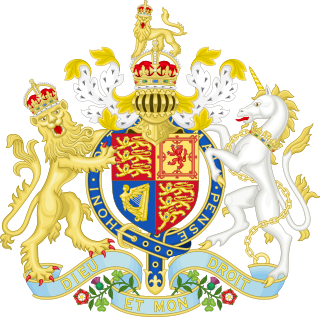Britain most often refers to:

Northern Ireland is a part of the United Kingdom in the north-east of the island of Ireland that is variously described as a country, province or region. Northern Ireland shares an open border to the south and west with the Republic of Ireland. At the 2021 census, its population was 1,903,175, making up around 3% of the UK's population and 27% of the population on the island of Ireland. The Northern Ireland Assembly, established by the Northern Ireland Act 1998, holds responsibility for a range of devolved policy matters, while other areas are reserved for the UK Government. The government of Northern Ireland cooperates with the government of Ireland in several areas under the terms of the Belfast Agreement. The Republic of Ireland also has a consultative role on non-devolved governmental matters through the British–Irish Governmental Conference (BIIG).
These are lists of Privy Counsellors of England, Great Britain and the United Kingdom from the reorganisation in 1679 of His Majesty's Most Honourable Privy Council to the present day. Members of the Privy Council of Ireland between 1660 and 1922 and of the Privy Council of Northern Ireland are also listed.
The Kingdom of Britain may refer to:
Londonderry was a parliamentary constituency in Northern Ireland represented in the House of Commons of the UK Parliament, as well as a constituency in elections to various regional bodies. It was replaced in boundary changes in 1983. Londonderry returned two MPs (1801–1885) and later one (1922–1983).

Ireland is an island in the North Atlantic Ocean.
The parliament of the Republic of Ireland is the Oireachtas.

According to the Constitution of Ireland, the names of the Irish state are Ireland (English) and Éire (Irish). From 1922 to 1937, its legal names were the Irish Free State (English) and Saorstát Éireann (Irish). The state has jurisdiction over almost five-sixths of the island of Ireland. The rest of the island is Northern Ireland, a part of the United Kingdom. In 1948 Ireland adopted the terms Republic of Ireland (English) and Poblacht na hÉireann (Irish) as the official descriptions of the state, without changing the constitutional names.

The Ireland Act 1949 is an Act of the Parliament of the United Kingdom intended to deal with the consequences of the Republic of Ireland Act 1948 as passed by the Irish parliament, the Oireachtas.
A national curriculum is a common programme of study in schools that is designed to ensure nationwide uniformity of content and standards in education. It is usually legislated by the national government, possibly in consultation with state or other regional authorities.

The Partition of Ireland was the process by which the Government of the United Kingdom of Great Britain and Ireland (UK) divided Ireland into two self-governing polities: Northern Ireland and Southern Ireland. It was enacted on 3 May 1921 under the Government of Ireland Act 1920. The Act intended both territories to remain within the United Kingdom and contained provisions for their eventual reunification. The smaller Northern Ireland was duly created with a devolved government and remained part of the UK. The larger Southern Ireland was not recognised by most of its citizens, who instead recognised the self-declared 32-county Irish Republic. On 6 December 1922, Ireland was partitioned. At that time, the territory of Southern Ireland left the UK and became the Irish Free State, now known as the Republic of Ireland.
Education in Ireland may refer to

The following outline is provided as an overview of and topical guide to Ireland:

Since 1922, the United Kingdom has been made up of four countries: England, Scotland, Wales and Northern Ireland. The UK Prime Minister's website has used the phrase "countries within a country" to describe the United Kingdom.

British rule in Ireland built upon the 12th century Anglo-Norman invasion of Ireland on behalf of the English king and eventually spanned several centuries that involved British control of parts, or the entirety, of the island of Ireland. Most of Ireland gained independence from the United Kingdom following the Anglo-Irish War in the early 20th century. Initially formed as a Dominion called the Irish Free State in 1922, the Republic of Ireland became a fully independent nation state following the passage of the Statute of Westminster in 1931. It effectively became a republic with the passage of a new constitution in 1937, and formally became a republic with the passage of the Republic of Ireland Act in 1949. Northern Ireland remains part of the United Kingdom as a constituent country.

Southern Ireland, South Ireland or South of Ireland may refer to:
Timeline of the COVID-19 pandemic in the United Kingdom may refer to:
This page is based on this
Wikipedia article Text is available under the
CC BY-SA 4.0 license; additional terms may apply.
Images, videos and audio are available under their respective licenses.






